Apple vs. Android location tracking: Time for some truth
April 25, 2011How to create your own WordPress functionality plugin
May 10, 2011By Peter Wylie
Are you wondering if it makes sense to advertise on your favorite social network? Facebook, Twitter and LinkedIn all have different demographic profiles and use cases that may provide good advertising opportunities.
All three platforms are also developing new and innovative ways to target advertising messages, based on the overwhelming amount of data they possess about their users. Marketers should explore the paid opportunities social networks offer with as much thought and effort as they experiment with the “earned” and “owned” aspects that these networks provide.
Depending on your business objective, one platform will likely prove more useful than others. In this article, I will explore the functionality each provides and how you can integrate the paid activity for maximum impact and return.
Facebook Ads
Facebook’s advertising platform is by far the most developed and widely used of the three major social networks. Offering a self-serve platform very similar to the early Google AdWords interface, Facebook advertising is available to even the smallest businesses with the most limited budgets.

Examples of Facebook ads.
Because the platform is still developing and underutilized, prices remain low for clicks and impressions when compared with more mature channels like Google AdWords and online display advertising.
Facebook allows users to target messages by a host of different criteria, which are determined from users’ profile information. Whether you want to reach 24- to 35-year-old women or 55- to 65-year-old men, people who like gardening or people who like jazz music, Facebook can deliver that demographic due to its scale and targeting capability.
Because much of the data Facebook has is of a demographic and interest level, Facebook advertising is very effective at B2C targeting. It also offers geographic targeting, which works well for metro areas and cities, but is somewhat lacking if you want to target rural areas specifically. Facebook advertising is relatively ineffective for B2B advertising, because the information it bases its targeting on is largely of a personal nature.
Facebook also allows users to run ads to attract “Likes” on their pages, which can help you grow your community on Facebook into a business asset. Paying for Likes can help your “owned” messages on Facebook reach a wider audience, and can be a prudent investment if managed closely. Before running Facebook ads to acquire Likes, however, it is very prudent to think through in rough terms the value you think you can obtain from having that line of contact with individuals.
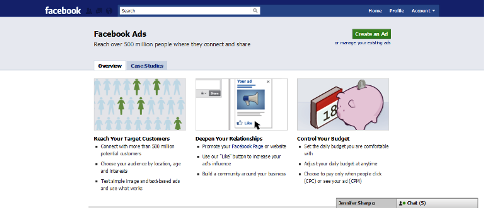
Connect with real people with a real interest in your products.
LinkedIn Ads
On the other hand, LinkedIn advertising is tremendously effective for B2B industries because of the professional information LinkedIn uses to target its advertisements, which are called “LinkedInAds”
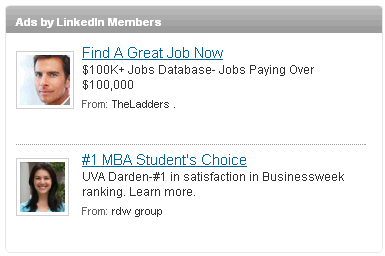
Examples of LinkedIn advertising.
LinkedIn allows you to deliver advertising only to people with certain qualifications or titles, such as VP of operations or director of marketing. This makes the advertising spending very efficient, and fast movers can also take advantage of the current low prices on the platform.
When setting up your LinkedIn campaign, also make sure to see if there are any relevant groups that you could use for your targeting. LinkedIn Groups draw users back for longer sessions, and this can be a great way to reach targeted individuals while they are considering business issues and topics in the group setting.
LinkedIn Ads are quickly growing in popularity, so be wary of quick spikes in the cost of advertising if you choose to establish a campaign through this network.
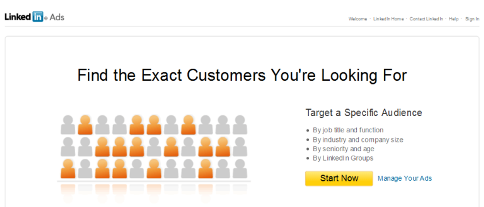
Reach your exact audience with LinkedIn Ads.
Twitter Ads
Currently the most underdeveloped advertising platform, Twitter only offers advertising to large brands at this time, in the form of “Sponsored Tweets” or “Promoted Trends.”
Advertisers pay per impression to have their tweet show up at the top of feeds when certain hashtags are used or for certain search terms on Twitter’s search engine.
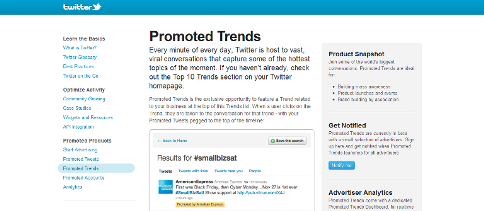
Promoted Trends give users something new and exciting to discover
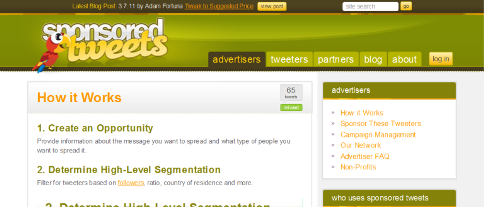
An advertising platform that connects advertisers with tweeters.
As a result, Twitter advertising is neither practical nor attainable for most marketers and businesses today. To warrant the valuations it has received, however, Twitter will almost certainly begin to offer an advertising product to smaller customers as it focuses on its monetization efforts.
Due to the real-time nature of much of the communication on Twitter, it holds tremendous promise for marketers, if the eventual mass-market advertising application can effectively harness this power to make ads more relevant and timely. Twitter’s value to smaller advertisers and marketers remains on the “earned” and “owned” side of the equation for the time being.
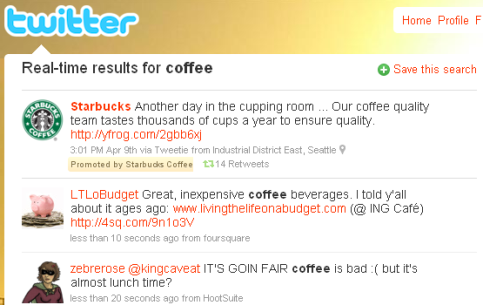
Example of Twitter advertising.
Overall
Marketers should think about their target customer base and begin experimenting with social media advertising to reach them at a lower cost. Each platform offers specific features and benefits that will be more relevant to some businesses than others. I suggest a “test and invest” approach in these new channels to determine what works before spending large sums.
What has been your experience with social media advertising? Leave your questions and comments in the box below
